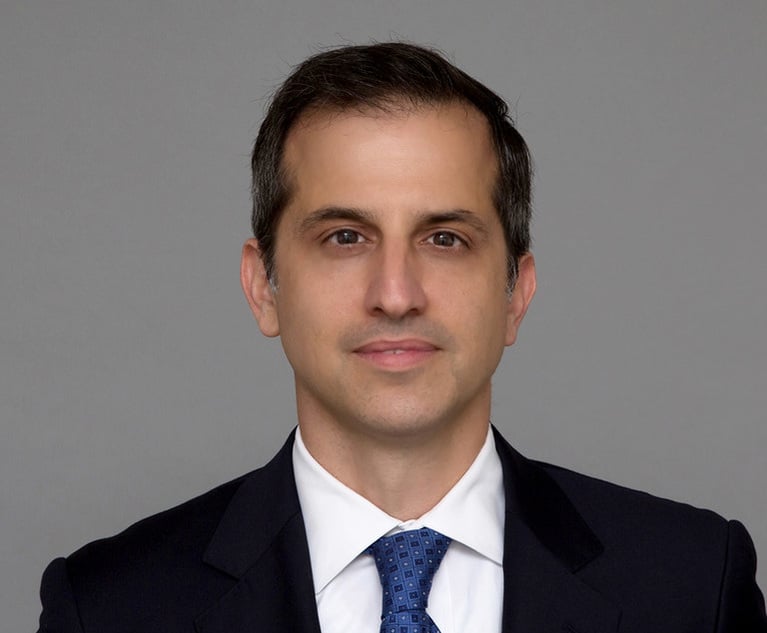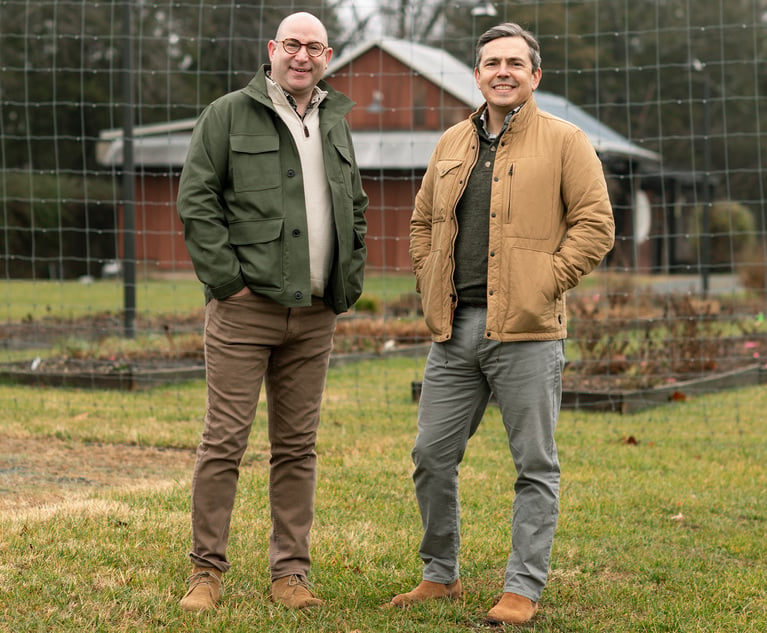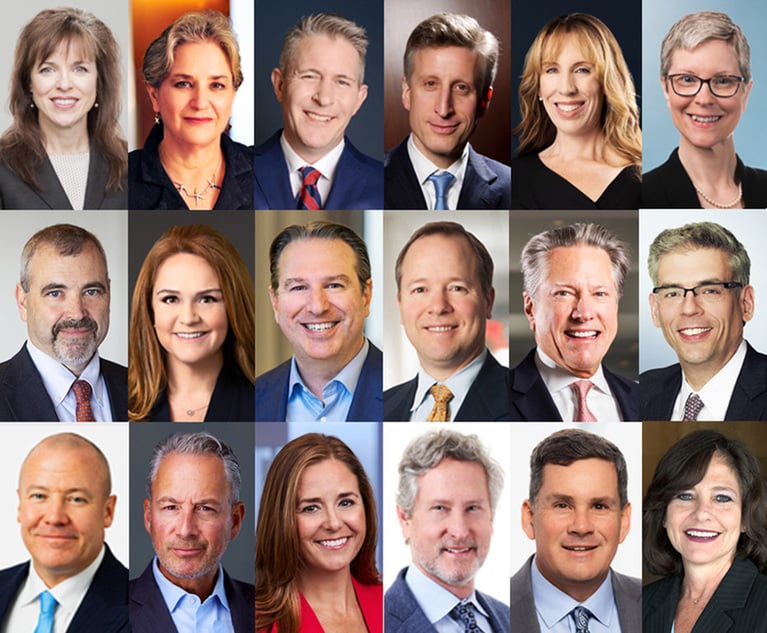Yes, 97 Percent of Cases Settle. But It Should Never Be the Only Option
When confronted with a significant lawsuit, every company, no matter the size or industry, must make a careful assessment of the risks involved in taking the case to trial.
September 11, 2018 at 06:28 PM
5 minute read
The original version of this story was published on National Law Journal

Multiple studies confirm that approximately 97 percent of all civil cases settle before trial. The percentage of cases involving multimillion-dollar damage claims that will be decided by a jury is even higher. Cases against big businesses with large footprints and concerns over public perception, higher still. Large corporations, especially those with recognizable brands, fear the attention that comes with a jury trial and the potential for a highly publicized, catastrophic verdict. But for some companies, the pendulum may have swung too far in favor of settlement.
As a result, these companies pay significant sums to settle cases that could be won at trial, or at least could result in a verdict for less than what it would cost to settle. Worse still, companies can unwittingly develop a reputation as an easy mark that will settle even weak and unjustified cases, encouraging more lawsuits. While settlement is certainly the best option in some cases, it shouldn't be the only option, even where a well-funded plaintiff can take a big-dollar damage claim to a jury.
|Case Study
Consider a case against a large, multinational company facing environmental contamination claims brought by a group of property owners. The property owners claimed their land and water had been contaminated by the company's historical operations. The landowners were well-funded and represented by big-name plaintiffs' lawyers.
The client had ongoing environmental problems that generated negative publicity, including in the state where the lawsuit was filed. And there was no dispute some contamination on the plaintiffs' property had come from the company's former facility, now a Superfund site. The plaintiffs initially asserted claims in the hundreds of millions, but they were reduced significantly by the judge's pretrial rulings. Nonetheless, the plaintiffs presented to the jury a request for $25 million in compensatory damages, plus a request for punitive damages, which could be as much as 10 times compensatory damages in this jurisdiction.
Based on these facts, the case might seem like an obvious one to settle—the equities appeared unfavorable, the exposure was significant, and a trial would be long, expensive and public. And there were opportunities to settle: A pre-complaint meeting, a court-ordered mediation, and discussions on the eve of and during trial. Although the plaintiffs' settlement demands were aggressive, our client was capable of paying such a settlement without a material effect on the company's finances, and had settled cases of similar magnitude before.
After an assessment of the totality of the case, however, attorneys determined that a jury was not likely to award the plaintiffs the amount they were demanding to settle. Those assumptions were vetted carefully, using most of the tools identified below, including a mock trial exercise where two separate jury panels returned verdicts. Both mock juries awarded some money to the plaintiffs, but significantly below the settlement demand. Confident in the risk assessment, and with a fully informed client, the case was tried over three weeks to a jury in federal court. The jury returned a complete defense verdict.
While the results of a trial can never be predicted with certainty, we believe the result in this case vindicated the assessment of the client's risk—which was confirmed not just by the outcome, but also by the post-verdict interviews with the jurors, many of whom echoed sentiments heard from our mock jurors. While a different jury might have returned a less favorable verdict, the risk assessment accurately predicted that most juries would return a verdict lower than the plaintiffs' settlement demand, which drove the decision to try the case.
|Assessing the Risk
When confronted with a significant lawsuit, every company, no matter the size or industry, must make a careful assessment of the risks involved in taking the case to trial. When facing such litigation, it is critical to have open and frank communication between counsel and client about the risks and potential exposure. This will assist the client in making informed decisions about whether and when to consider settlement, and will educate the attorney about the client's risk tolerance—both monetarily and otherwise.
Early on, it is important to develop a preliminary assessment of settlement value and strategy, and to reassess that settlement value and strategy at regular intervals throughout the case. This should include a holistic assessment of settlement—not just the dollars and cents directly at issue in the case, but also intangible factors such as potential negative publicity, organizational costs in terms of manpower and inconvenience, the possibility of additional lawsuits involving the same subject matter, and the precedent that could be set by an unfavorable outcome at trial.
There are a number of tools available to help assess these risks. Jury consultants can provide venue and jury pool research, including surveys and demographic information. Focus groups and mock trials provide valuable insight into how a factfinder might react to the evidence—particularly where the participants are from the same or similar locale as the jury pool. Internal “peer review” sessions with the client's management and lawyers who are not directly involved in the case also provide more objective insight into how the evidence may be received, and further educate the client about the strengths and weaknesses of its case. These and other tools can assist a client in determining whether to settle (and at what price point), or whether to try the case with a better understanding of the risks and likely outcomes.
Jonathan Rauchway is a partner and James Henderson is an associate at Davis Graham & Stubbs in Denver. Their practices focus on environmental and natural resources litigation.
This content has been archived. It is available through our partners, LexisNexis® and Bloomberg Law.
To view this content, please continue to their sites.
Not a Lexis Subscriber?
Subscribe Now
Not a Bloomberg Law Subscriber?
Subscribe Now
NOT FOR REPRINT
© 2025 ALM Global, LLC, All Rights Reserved. Request academic re-use from www.copyright.com. All other uses, submit a request to [email protected]. For more information visit Asset & Logo Licensing.
You Might Like
View All
Litigation Leaders: Jason Leckerman of Ballard Spahr on Growing the Department by a Third Via Merger with Lane Powell

Litigation Leaders: Greenspoon Marder’s Beth-Ann Krimsky on What Makes Her Team ‘Prepared, Compassionate and Wicked Smart’

Why the Founders of IP Boutique Fisch Sigler Are Stepping Away From the Law and Starting an AI Venture
Trending Stories
Who Got The Work
Michael G. Bongiorno, Andrew Scott Dulberg and Elizabeth E. Driscoll from Wilmer Cutler Pickering Hale and Dorr have stepped in to represent Symbotic Inc., an A.I.-enabled technology platform that focuses on increasing supply chain efficiency, and other defendants in a pending shareholder derivative lawsuit. The case, filed Oct. 2 in Massachusetts District Court by the Brown Law Firm on behalf of Stephen Austen, accuses certain officers and directors of misleading investors in regard to Symbotic's potential for margin growth by failing to disclose that the company was not equipped to timely deploy its systems or manage expenses through project delays. The case, assigned to U.S. District Judge Nathaniel M. Gorton, is 1:24-cv-12522, Austen v. Cohen et al.
Who Got The Work
Edmund Polubinski and Marie Killmond of Davis Polk & Wardwell have entered appearances for data platform software development company MongoDB and other defendants in a pending shareholder derivative lawsuit. The action, filed Oct. 7 in New York Southern District Court by the Brown Law Firm, accuses the company's directors and/or officers of falsely expressing confidence in the company’s restructuring of its sales incentive plan and downplaying the severity of decreases in its upfront commitments. The case is 1:24-cv-07594, Roy v. Ittycheria et al.
Who Got The Work
Amy O. Bruchs and Kurt F. Ellison of Michael Best & Friedrich have entered appearances for Epic Systems Corp. in a pending employment discrimination lawsuit. The suit was filed Sept. 7 in Wisconsin Western District Court by Levine Eisberner LLC and Siri & Glimstad on behalf of a project manager who claims that he was wrongfully terminated after applying for a religious exemption to the defendant's COVID-19 vaccine mandate. The case, assigned to U.S. Magistrate Judge Anita Marie Boor, is 3:24-cv-00630, Secker, Nathan v. Epic Systems Corporation.
Who Got The Work
David X. Sullivan, Thomas J. Finn and Gregory A. Hall from McCarter & English have entered appearances for Sunrun Installation Services in a pending civil rights lawsuit. The complaint was filed Sept. 4 in Connecticut District Court by attorney Robert M. Berke on behalf of former employee George Edward Steins, who was arrested and charged with employing an unregistered home improvement salesperson. The complaint alleges that had Sunrun informed the Connecticut Department of Consumer Protection that the plaintiff's employment had ended in 2017 and that he no longer held Sunrun's home improvement contractor license, he would not have been hit with charges, which were dismissed in May 2024. The case, assigned to U.S. District Judge Jeffrey A. Meyer, is 3:24-cv-01423, Steins v. Sunrun, Inc. et al.
Who Got The Work
Greenberg Traurig shareholder Joshua L. Raskin has entered an appearance for boohoo.com UK Ltd. in a pending patent infringement lawsuit. The suit, filed Sept. 3 in Texas Eastern District Court by Rozier Hardt McDonough on behalf of Alto Dynamics, asserts five patents related to an online shopping platform. The case, assigned to U.S. District Judge Rodney Gilstrap, is 2:24-cv-00719, Alto Dynamics, LLC v. boohoo.com UK Limited.
Featured Firms
Law Offices of Gary Martin Hays & Associates, P.C.
(470) 294-1674
Law Offices of Mark E. Salomone
(857) 444-6468
Smith & Hassler
(713) 739-1250







